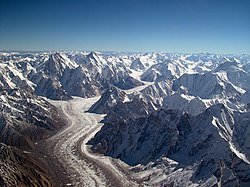Glacier

A glacier is a large body of ice and snow. It forms because the snow in an area does not all melt in summer. Each winter, more snow is added. The weight of all of the snow creates pressure, which turns the lower parts of the snow into ice. After that happens for many years, the glacier eventually becomes large and so heavy that gravity causes the ice to move.
A glaccier flows downwards like water but very slowly. It moves about 50 m (160 ft) per year. New snow replaces the parts of the glacier that flow away.[1][2]
Glaciers are the largest sources of fresh water on Earth. The largest bodies of salt water are the oceans.
Creation

Glaciers form only in places that are cold enough and get enough snow over time. That can take a long time, and it often takes tens or hundreds of years for a glacier to form. There are two kinds of glaciers: continental glaciers and alpine glaciers (also called mountain glaciers):
- Continental glaciers are glaciers that spread out over a large area of land and were created mostly during the Ice Ages. There are still some continental glaciers in Greenland and Antarctica. They often flow downwards into the sea and break up. The broken parts that float in the sea are called icebergs.
- Alpine glaciers form in mountain areas and are smaller than continental glaciers. Alpine glaciers usually flow until they reach a place that the temperature is warm enough that the ice melts completely during the summer.
Effects
Glaciers are very important and a large effects on the environment because they are very large and heavy. When they move, they erode mountains and land. Also, since they froze long ago, snow crystals and air bubbles in them are kept in good condition. They can provide a large amount of information for scientists.
Recently, glaciers have been melting more than they in the past. Many scientists think that is because ecause global warming is changing the climate.[3]
Appearance
Glaciers are blue in color because water is very good at absorbing light. Only the strongest light, with the most energy, can escape. Blue is the color of light that has the most energy, which makes it the only color of light that can escape without being absorbed. The thicker the glacier, the more it appears blue.
Glacier Media
Glacier of the Geikie Plateau in Greenland
The Taschachferner in the Ötztal Alps in Austria. The mountain to the left is the Wildspitze (3.768 m), second highest in Austria
With 7,253 known glaciers, Pakistan contains more glaciers than any other country on Earth outside the polar regions. At 62 kilometres (39 mi) in length, the pictured Baltoro Glacier is the fifth longest alpine glacier in the world.
The Quelccaya Ice Cap in Peru is the second-largest glaciated area in the tropics
Webber Glacier on Grant Land is an advancing polar glacier
A glacier cave located on the Perito Moreno Glacier in Argentina
Differential erosion enhances relief, as clear in this very steep-sided Norwegian fjord.
Ice cracks in the Titlis Glacier
References
- ↑ Hambrey, Michael; Alean, Jürg (2004). Glaciers (2nd ed.). Cambridge University Press. ISBN 0-521-82808-2. OCLC 54371738.
- ↑ Benn, Douglas I.; Evans, David J.A. (1999). Glaciers and glaciation. Arnold. ISBN 0470236515. OCLC 38329570.
- ↑ *Bennett, M.R.; Glasser N.F. (1996). Glacial geology: ice sheets and landforms. John Wiley & Sons. ISBN 0471963445. OCLC 33359888. 37536152.
Uncited references
- Walley, Robert (1992). Introduction to physical geography. Wm. C. Brown.
Other websites
| Wikimedia Commons has media related to Lua error in Module:Commons_link at line 62: attempt to index field 'wikibase' (a nil value).. |
- Swisseduc - Glaciers online Website on Glaciers in English and German
- Time lapse movies of Grosser Aletschgletscher
- Illustrated glossary on Glaciers online, in English and German
- Glacier information for schools
- National Snow and Ice Data Center - Glaciers Archived 2007-01-16 at the Wayback Machine
- USGS Glacier Studies Project Archived 2007-01-13 at the Wayback Machine
- Glaciers and Glacial Hazards - USGS
- 2003-08-15 Scientists Rewrite Laws Of Glacial Erosion
- Fjords National Park, Alaska
- NOVA scienceNOW - A 7-minute video of the NOVA broadcast of July 26, 2005. Hosted by Robert Krulwich, the video is about the world's fastest glacier and why it is moving too fast.










